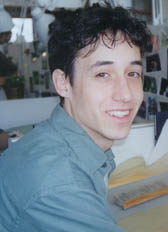Cornell undergraduate's team design makes top three, but not number one, in World Trade Center memorial competition
By Linda Myers

"Garden of Lights," a design by a team that included Cornell University undergraduate Sean Corriel, was one of three finalists in the competition for a memorial at the site of the former World Trade Center in New York City.
Corriel's team, which also involved a student and a professor from other institutions as well as significant input from Cornell professor of horticulture Nina Bassuk, made it to the top-three slot Jan. 5, beating out 5,200 entries and five other semifinalist teams. The team finally was bested Jan. 6 by another entry, "Reflecting Absence" by architect Michael Arad and landscape architect Peter Walker. The decision was made by a jury of 13 people, most of them professionals in the arts and academia, following much public input and 12 hours of deliberation in Gracie Mansion, the New York City mayoral residence.
"It was a long day of waiting on the edge of our seats and an amazing journey for Sean. We are very proud of his accomplishments," said Associate Professor Kathryn Gleason, chair of Cornell's Department of Landscape Architecture, where Corriel is a student. Gleason also noted that Bassuk, who had advised Corriel and his team on their design early on but was not one of the initial designers, became very involved in the final version. "She put in long hours to help the team make a garden that would thrive in its very difficult site, and she deserves great kudos as well."
Gleason added: "The winning schemes point to the value of collaboration between the professions in these complex urban environments. I hope the joint efforts bring landscape architecture into the public eye -- as well as into more collaborations with architects, urban planners and artists at the student and professional levels."
Corriel grew up in Huntington, N.Y., on Long Island and transferred into Cornell as a sophomore in 2000. Currently working on an honors thesis for his bachelor of landscape architecture degree, he plans to enter a master's program in architecture after he graduates.
The "Garden of Lights" memorial proposed by Corriel's team emphasizes the link, real and metaphorical, between earth and sky, life, death and memory. The final proposal, developed from the one that placed among the top eight last November, calls for two levels, instead of an initial three levels. On the top, meadows bloom over the footprint of the Twin Towers and open to an apple orchard with walking paths defined by some of the salvaged steel of the towers. "The area is intended to be life enhancing and evoke a sense of rebirth," said Bassuk.
One path leads to the memorial's lower level, a quieter, more meditative space, Bassuk said. It contains a wall, made from the bulk of the salvaged steel, engraved with the names of those who died in the terrorist attacks. Beams of light representing each of the victims stream from the floor upward, illuminating at night the trees in the orchard above. During the day, ambient light from above passes through to the lower level.
In addition to Corriel and Bassuk, those involved with the final "Garden of Lights" proposal were Pierre David, a faculty member at the Ecole d'Architecture de Clermont-Ferrand in France and at the New York/Paris Shape-of-Two-Cities program administered by Columbia University; and Jessica Kmetovic, a fifth-year student in the bachelor of architecture program at the California College of Arts and Crafts. Corriel, David and Kmetovic began working on the project independently, following their meeting through the study-abroad program.
The competition was sponsored by the Lower Manhattan Development Corp. and drew entries from 63 countries and 49 states. Another team of semifinalists among the eight initially chosen in November 2003 includes two Cornell alumni, Joseph Karadin and Hsin-Yi Wu, both B. Arch. '97, for their design "Suspending Memory."
Media Contact
Get Cornell news delivered right to your inbox.
Subscribe